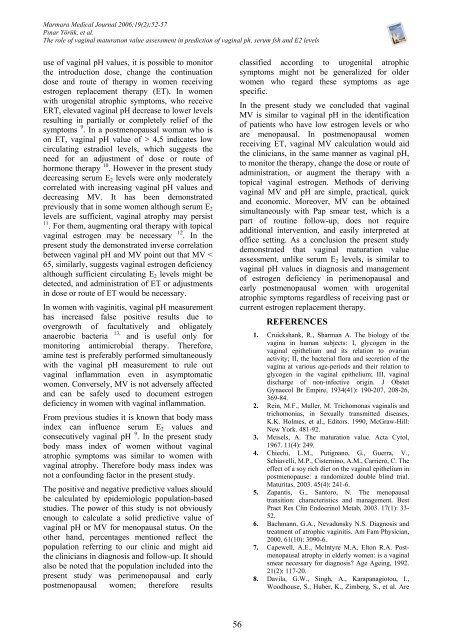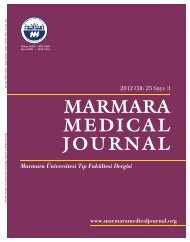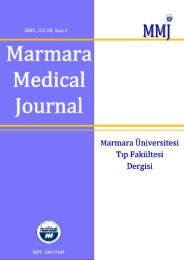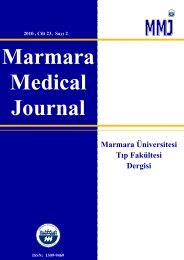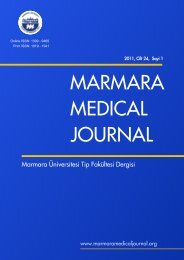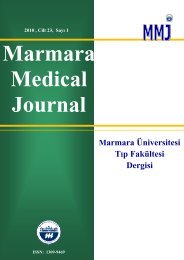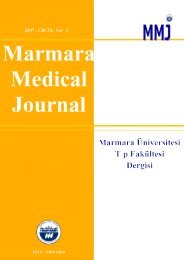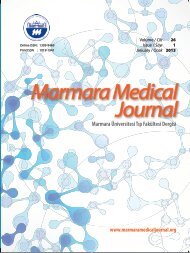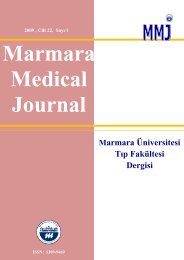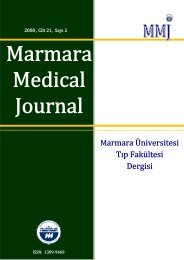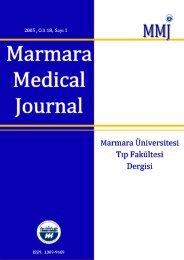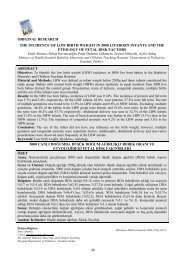Tam Metin PDF (3983 KB) - Marmara Medical Journal
Tam Metin PDF (3983 KB) - Marmara Medical Journal
Tam Metin PDF (3983 KB) - Marmara Medical Journal
You also want an ePaper? Increase the reach of your titles
YUMPU automatically turns print PDFs into web optimized ePapers that Google loves.
<strong>Marmara</strong> <strong>Medical</strong> <strong>Journal</strong> 2006;19(2);52-57<br />
Pınar Yörük, et al.<br />
The role of vaginal maturatıon value assessment in prediction of vaginal ph, serum fsh and E2 levels<br />
use of vaginal pH values, it is possible to monitor<br />
the introduction dose, change the continuation<br />
dose and route of therapy in women receiving<br />
estrogen replacement therapy (ET). In women<br />
with urogenital atrophic symptoms, who receive<br />
ERT, elevated vaginal pH decrease to lower levels<br />
resulting in partially or completely relief of the<br />
symptoms 9 . In a postmenopausal woman who is<br />
on ET, vaginal pH value of > 4,5 indicates low<br />
circulating estradiol levels, which suggests the<br />
need for an adjustment of dose or route of<br />
hormone therapy 10 . However in the present study<br />
decreasing serum E 2 levels were only moderately<br />
correlated with increasing vaginal pH values and<br />
decreasing MV. It has been demonstrated<br />
previously that in some women although serum E 2<br />
levels are sufficient, vaginal atrophy may persist<br />
11 . For them, augmenting oral therapy with topical<br />
vaginal estrogen may be necessary 12 . In the<br />
present study the demonstrated inverse correlation<br />
between vaginal pH and MV point out that MV <<br />
65, similarly, suggests vaginal estrogen deficiency<br />
although sufficient circulating E 2 levels might be<br />
detected, and administration of ET or adjustments<br />
in dose or route of ET would be necessary.<br />
In women with vaginitis, vaginal pH measurement<br />
has increased false positive results due to<br />
overgrowth of facultatively and obligately<br />
anaerobic bacteria 13, and is useful only for<br />
monitoring antimicrobial therapy. Therefore,<br />
amine test is preferably performed simultaneously<br />
with the vaginal pH measurement to rule out<br />
vaginal inflammation even in asymptomatic<br />
women. Conversely, MV is not adversely affected<br />
and can be safely used to document estrogen<br />
deficiency in women with vaginal inflammation.<br />
From previous studies it is known that body mass<br />
index can influence serum E 2 values and<br />
consecutively vaginal pH 9 . In the present study<br />
body mass index of women without vaginal<br />
atrophic symptoms was similar to women with<br />
vaginal atrophy. Therefore body mass index was<br />
not a confounding factor in the present study.<br />
The positive and negative predictive values should<br />
be calculated by epidemiologic population-based<br />
studies. The power of this study is not obviously<br />
enough to calculate a solid predictive value of<br />
vaginal pH or MV for menopausal status. On the<br />
other hand, percentages mentioned reflect the<br />
population referring to our clinic and might aid<br />
the clinicians in diagnosis and follow-up. It should<br />
also be noted that the population included into the<br />
present study was perimenopausal and early<br />
postmenopausal women; therefore results<br />
classified according to urogenital atrophic<br />
symptoms might not be generalized for older<br />
women who regard these symptoms as age<br />
specific.<br />
In the present study we concluded that vaginal<br />
MV is similar to vaginal pH in the identification<br />
of patients who have low estrogen levels or who<br />
are menopausal. In postmenopausal women<br />
receiving ET, vaginal MV calculation would aid<br />
the clinicians, in the same manner as vaginal pH,<br />
to monitor the therapy, change the dose or route of<br />
administration, or augment the therapy with a<br />
topical vaginal estrogen. Methods of deriving<br />
vaginal MV and pH are simple, practical, quick<br />
and economic. Moreover, MV can be obtained<br />
simultaneously with Pap smear test, which is a<br />
part of routine follow-up, does not require<br />
additional intervention, and easily interpreted at<br />
office setting. As a conclusion the present study<br />
demonstrated that vaginal maturation value<br />
assessment, unlike serum E 2 levels, is similar to<br />
vaginal pH values in diagnosis and management<br />
of estrogen deficiency in perimenopausal and<br />
early postmenopausal women with urogenital<br />
atrophic symptoms regardless of receiving past or<br />
current estrogen replacement therapy.<br />
REFERENCES<br />
1. Cruickshank, R., Sharman A. The biology of the<br />
vagina in human subjects: I, glycogen in the<br />
vaginal epithelium and its relation to ovarian<br />
activity; II, the bacterial flora and secretion of the<br />
vagina at various age-periods and their relation to<br />
glycogen in the vaginal epithelium; III, vaginal<br />
discharge of non-infective origin. J Obstet<br />
Gynaecol Br Empire, 1934(41): 190-207, 208-26,<br />
369-84.<br />
2. Rein, M.F., Muller, M. Trichomonas vaginalis and<br />
trichomonias, in Sexually transmitted diseases,<br />
K.K. Holmes, et al., Editors. 1990, McGraw-Hill:<br />
New York. 481-92.<br />
3. Meisels, A. The maturation value. Acta Cytol,<br />
1967. 11(4): 249.<br />
4. Chiechi, L.M., Putignano, G., Guerra, V.,<br />
Schiavelli, M.P., Cisternino, A.M., Carriero, C. The<br />
effect of a soy rich diet on the vaginal epithelium in<br />
postmenopause: a randomized double blind trial.<br />
Maturitas, 2003. 45(4): 241-6.<br />
5. Zapantis, G., Santoro, N. The menopausal<br />
transition: characteristics and management. Best<br />
Pract Res Clin Endocrinol Metab, 2003. 17(1): 33-<br />
52.<br />
6. Bachmann, G.A., Nevadunsky N.S. Diagnosis and<br />
treatment of atrophic vaginitis. Am Fam Physician,<br />
2000. 61(10): 3090-6.<br />
7. Capewell, A.E., McIntyre M.A, Elton R.A. Postmenopausal<br />
atrophy in elderly women: is a vaginal<br />
smear necessary for diagnosis? Age Ageing, 1992.<br />
21(2): 117-20.<br />
8. Davila, G.W., Singh, A., Karapanagiotou, I.,<br />
Woodhouse, S., Huber, K., Zimberg, S., et al. Are<br />
56


